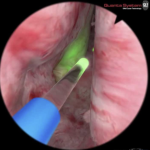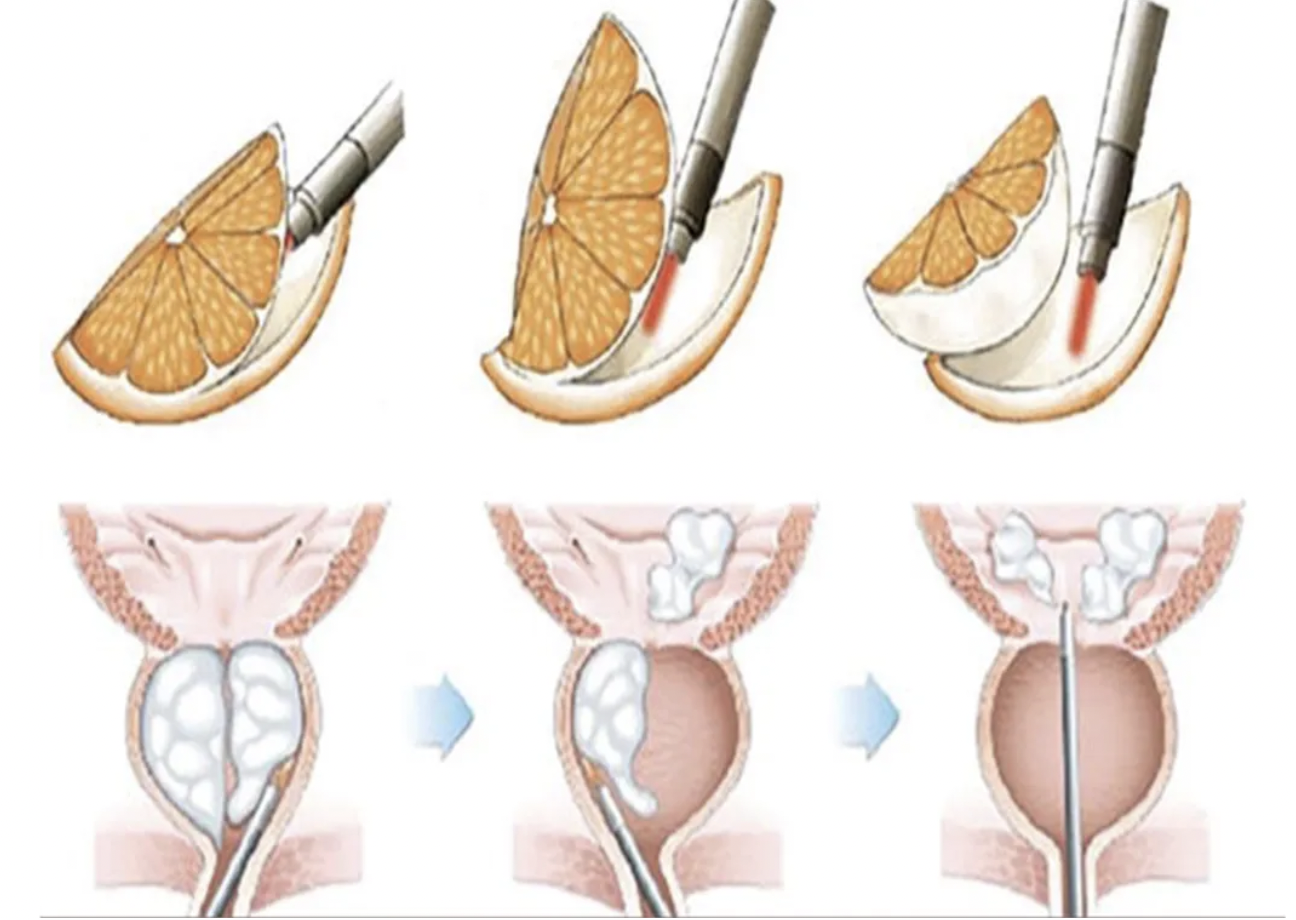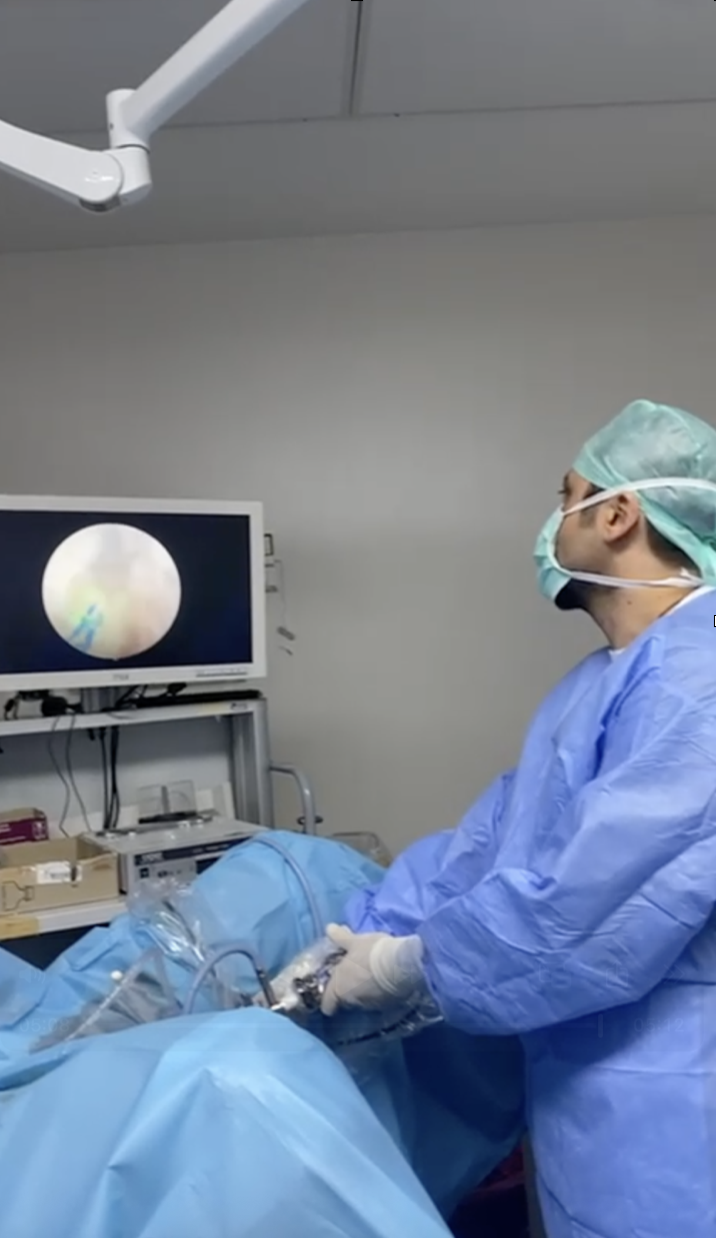
What is GreenLight Laser Treatment?
23 July 2025
ThuLEP Surgery – What is ThuLEP?
23 July 2025HoLEP Surgery - What is HoLEP?
HoLEP involves the removal of tissue blocking the prostate using a laser fiber passed through a telescope inserted into the penis (urethra).
- The prostate gland is located around the urethra (the tube that carries urine from the bladder) and can block urine flow when it enlarges.
- The procedure involves inserting a telescope through your urethra (urinary tract) and using a laser to "peel away" the central part of your prostate gland, creating a wider channel that allows urine to flow more easily.
- A catheter will be inserted into the bladder for 24 to 72 hours after the operation to clear blood clots.
• It is highly effective in improving urinary symptoms associated with obstruction at the bladder outlet and in men who are unable to urinate and require continuous catheterization:
• The most common side effects include the absence of semen during ejaculation (retrograde ejaculation), temporary bleeding, a burning sensation, or frequent urination

Who is a candidate for HoLEP surgery?
- HoLEP surgery can be performed on all patients with prostate enlargement of 30 grams or more, but it is particularly recommended for patients with larger prostates.
-
When will the HoLEP surgery take place?
Your urologist (or a member of their team) will briefly review your medical history and medications and will discuss the procedure with you again to confirm your consent. - An anesthesiologist will discuss general anesthesia or spinal anesthesia options with you. The anesthesiologist will also talk to you about pain management after the procedure.
- You may be given compression stockings before the procedure and an injection of a blood-thinning medication to help prevent blood clots from forming and traveling to your lungs. Your medical team will decide whether you need to continue these precautions after you return home.
How is the HoLEP procedure performed?
- We usually use general anesthesia (where you are asleep) or spinal anesthesia (where you do not feel anything below the waist).
• Before the procedure, you will be given an antibiotic injection after being checked for any allergies
• We insert a telescope into the bladder through the urethra and use a laser fiber to remove pieces of prostate tissue (prostate lobes) that are causing the blockage from the prostate capsule; the removed pieces are washed out into the bladder
• We remove these pieces from the bladder using a special device called a morcellator, which grinds and suctions them
• We send the removed prostate tissue for microscopic pathological examination
• After the prostate tissue is removed, we carefully cauterize any bleeding points in the surgical cavity using a laser
• At the end of the procedure, we insert a catheter into your bladder
• For a short period after surgery, we perform irrigation by administering fluid through the catheter into the bladder to clean any clots or bleeding
• The procedure typically takes about one to two hours, depending on the size of your prostate
• You will typically stay in the hospital overnight, though discharge on the day of surgery may be possible for some patients
- We usually remove your urinary catheter within the first 1-2 days after surgery. At first, you may feel pain when urinating and you may need to urinate more frequently than usual. These initial discomforts can be relieved with painkillers such as Paracetamol; frequent urination usually begins to improve within a few days.
- Since the laser technique removes a significant amount of tissue, you may initially experience some loss of bladder control. This condition improves as the pelvic floor muscles heal after surgery and typically returns to normal within a short period in most men.
- Blood may be seen in your urine within 24 to 48 hours after the catheter is removed, and some patients may be unable to urinate at this stage. In such cases, we temporarily insert a new catheter, which allows the swelling caused by the operation to subside. You will usually go home with this catheter and return approximately one week later to have it removed; this procedure is successful in almost all patients.

What Are the Advantages of HoLEP Surgery?
- HoLEP surgery is performed on an outpatient basis.
- The surgery can be performed in a short time even in cases of very large prostates.
- Bleeding during the procedure is significantly less than with other methods, even in cases of very large prostates.
- The catheter can be removed one or two days after the surgery, and the patient can be discharged home.
- Since a large amount of tissue is removed during surgery, the risk of recurrence is very low.
- Risks such as burning, pain, bleeding, and sexual side effects that may occur after surgery are less common.
What are the risks of HoLEP surgery?
Possible side effects and the risk of these side effects are listed below. Some side effects may resolve on their own or be reversible, while others may be permanent. Very rare side effects (occurring in fewer than 1 in 250 patients) are not listed individually.
The effects of these side effects can vary greatly from patient to patient; it is important to discuss these risks and their potential effects on you with your surgeon:
|
Side effect |
Risk |
|
Temporary mild burning, bleeding, and frequent urination |
Almost all patients |
|
During ejaculation, semen enters the bladder and does not come out (retrograde ejaculation) |
In 9 out of 10 patients (90%) |
|
Blood in the urine for a few days after surgery |
In 1 out of every 2 to 10 patients |
|
Temporary, short-term urinary incontinence (can be corrected with pelvic floor exercises) |
In 1 out of every 10 to 50 patients |
|
Treatment may not eliminate all your symptoms |
In 1 out of every 50 to 250 patients |
|
Bleeding requiring a blood transfusion or reoperation |
In 1 out of every 50 to 250 patients |
What can I expect after HoLEP surgery when I go home?
• You will be given advice on the recovery process at home• A copy of your discharge summary will be provided to you
- Any antibiotics or other medications you need will be provided by the hospital pharmacy.
• For the first 24 to 48 hours, you should drink twice as much fluid as usual; this helps cleanse your system and reduce the risk of infection
• You may return to work once you feel sufficiently comfortable and your family doctor has approved your recovery
• One in five patients (20%) may experience mild bleeding 2–3 weeks after going home due to the separation of scabs in the prostate area. In this case, you should increase your fluid intake; if it does not improve, contact your doctor.
• If you experience severe bleeding, clotting, or sudden inability to urinate, contact your doctor immediately; this may require emergency hospitalization. - Some loss of bladder control is common in the early days, so it is helpful to start pelvic floor exercises as soon as possible; these exercises can improve your bladder control at home. For more information about these exercises, click on the link or consult your urology nurse. Symptoms of an overactive bladder (frequent and sudden urge to urinate) may take up to three months to fully resolve, while urine flow usually improves immediately.
- The final biopsy results from the tissue samples taken usually take 7–10 days. All biopsies that reveal unexpected cancer in your prostate will be reviewed in detail by a multidisciplinary team of specialists before any decision on further treatment is made. The results will be discussed with you and your specialist team before being communicated to you and your family doctor.
- Most patients need to rest at home for two to three weeks before returning to work. If you have a physically demanding job, we recommend resting for three to four weeks before returning to work; you should avoid heavy lifting during the recovery process.
- HoLEP Surgery and Driving: As with all prostate surgeries, it is important to avoid prolonged sitting during the first six weeks following HoLEP surgery.
FAQ
HoLEP Surgery Frequently Asked Questions
1What is HoLEP?
HoLEP is a procedure in which prostate tissue is removed using a laser through the urethra (the tube that carries urine from the bladder) using an endoscopic instrument (resectoscope).
2What are the advantages of HoLEP?
No incisions are made during HoLEP surgery, and bleeding is minimal. The risks of post-operative complications such as burning, pain, bleeding, and sexual side effects are lower.
3What is the recovery process like after HoLEP?
After HoLEP surgery, patients typically stay in the hospital for one night, and the catheter is removed the next day before the patient is discharged home. Since there are no external incisions or scars after the surgery, the recovery process is relatively quick.
4Who is a suitable candidate for HoLEP surgery?
HoLEP surgery can be performed on all patients with prostate enlargement of 30 grams or more, but it is particularly recommended for patients with larger prostates.
5Is HoLEP Surgery Easy?
When considering patient comfort, HoLEP surgery appears to be relatively straightforward both during and after the procedure. However, the method requires significant surgical expertise, and inexperienced hands may face serious challenges for both the patient and the surgeon.
6Is HoLEP Surgery Risky?
HoLEP surgery is less risky due to its advantages such as less bleeding and shorter hospital stays. However, both anesthesia-related and surgery-related risks should be evaluated with your doctor on a case-by-case basis.
7How Long Does HoLEP Surgery Take?
The duration of HoLEP surgery varies depending on the size of the prostate but typically lasts approximately 45–90 minutes.
8What is the cost of HoLEP surgery in Istanbul?
HoLEP surgery costs may be higher than other methods due to the laser energy and materials used. However, when considering the total cost, the advantages of lower post-surgery complications and shorter hospital stays may make it more cost-effective.
